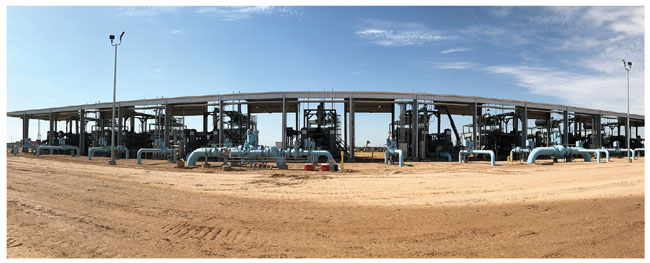
New Tools Yielding Nimble Operators
By Kala D. Schmidt
When Warren Buffett makes a significant investment in an unlikely industry, the world takes notice. So when Berkshire Hathaway put up $10 billion to help Occidental Petroleum win the Anadarko Petroleum prize, it sent sparks through the energy sector.
Backing Occidental seemed an unlikely move for Buffett. The last major energy investment came when Berkshire Hathaway bought about 26 million shares of Kinder Morgan. Berkshire Hathaway’s energy investments primarily are in power generation and transmission and include renewables such as wind and hydroelectric generation. Buffett’s latest investment signaled a vote of confidence in the oil industry’s largest takeover in years–even if Occidental had to quadruple its debt and sell $4.55 billion of its assets to make the deal happen. The acquisition included 10,000 drilling locations in the Permian Basin, which produces a third of all U.S. oil.
Mergers and acquisitions in the energy sector have since quieted alongside lower price decks. Nevertheless, the Permian Basin will be a bellwether for the heretofore unquestionable vitality of U.S. shale oil and the production growth it has ushered in. Fortunately, computing power has evolved to the point as to make a real difference in today’s industry conditions. Astute operators can take advantage of cutting-edge software, information technology solutions and consulting services to shrink their costs and make smart decisions with the sort of agility the market requires. In a fast-paced world where decisions in China can influence the best course of action in Midland, it is the nimble companies that flourish.
Infrastructure Growth
Major players have joined middle-market companies and startups exploring for oil in the vast Permian. While the playing field may have become overly exuberant with acreage acquisitions and unbridled growth through the drill bit, the good news is that take-away capacity from the infrastructure build-out is well under way. Multiple Permian-to-Gulf pipelines will provide the necessary take-away capacity at least through the end of 2020.
Of course, in the brave new era of unconventional resources, multiphase production also requires pipelines to transport natural gas to markets. The industry has seen continued funding and progress on both the build-out of crude oil and natural gas infrastructure. The new Gulf Coast Express, for example, transports about 2 billion cubic feet a day. The early completion of this pipeline represents the industry’s resolve to move Permian oil and gas production to export markets.
Kinder Morgan’s Waha compressor station moves natural gas through the Gulf Coast Express Pipeline to Agua Dulce near Texas Gulf Coast infrastructure. In service ahead of schedule, the GCX pipeline added approximately 2.0 Bcf/d to Permian Basin take-away capacity.
Although companies are expected to continue the upward trajectory of Permian production during the next several years, producers drilling from the basin’s western side are extracting a new stream of light crude oil. It has become well known that many U.S. refineries are not configured to process this lighter American oil; they were designed for the heavy crude that the United States imports from its neighbors to the north and south. That demand has grown amid embargos against Venezuela, bottlenecks in Canada, and production slowdowns in Mexico. As a result, producers have started to sell the light oil, effectively securing a new market that can help increase U.S. crude exports.
While plenty of excitement pervades the Permian Basin, major players have suggested their smaller rivals are overly optimistic about their hoped-for prices. If these big companies are not buying what their smaller rivals are selling, some may conclude that the consolidation taking place is not indicative of a new wave of shale oil, but rather a bunch of small players trying to squeeze blood from a stone.
More indicative still are the rumblings that a growing number of companies now face the possibility of bankruptcy associated with excess U.S. shale production. Others are trying to sell noncore assets in the Permian to improve their balance sheets.
Shale Light Oil
While industry consolidation may make production more efficient, the oil coming from the ground in the Permian Basin and elsewhere in the United States needs those foreign markets. Shale oil is ill-suited for producing jet fuel or diesel, and its low octane levels make it a poor fit for newer cars’ high-efficiency engines. Although U.S. crude exports are projected to continue growing, existing refining capacity requires balancing increased domestic light oil production with heavier crude imports.
With their higher break-even points, shale projects are especially vulnerable during an economic slump. Most new Permian wells break even at about $50 a barrel. This keeps production profitable when oil prices hover close to $60 a barrel, but producers feel the pinch when oil prices dip below that.
While the boom in the Permian Basin provides the Trump administration enormous political leverage in the Middle East and at home, shale isn’t going to solve every U.S. energy problem. On the surface, it has spawned economic growth and lowered prices for American consumers. After all, shale production is on pace to help the United States surpass the Organization of Petroleum Exporting Companies in crude oil output during the next several years. Even so, problems arise when trade issues become so entangled with national security.
Some analysts deduce the more the U.S. economy relies on crude oil exports, the more vulnerable the country becomes to trade retaliation. Backed into a corner by OPEC cuts and instability in Venezuela, China stockpiled 350,000 bbl/d recently. Later, oil prices dropped after China placed tariffs on U.S. crude in the two nations’ ongoing trade war.
Volatility Defense
These geopolitical events create ripple effects that touch every aspect of the production chain. When the value of assets such as those in the Permian is so mercurial, companies need real-time data available and preconfigured for their use.
If China slaps more tariffs on U.S. oil, producers need to know as soon as possible. When hotbeds such as the Permian Basin begin to cool, companies that are ahead of the curve are best able to weather the storm. Companies up and down the production chain must be able to react to new developments and implement changes instantly.
In the Permian business environment, timely and accurate data analysis is critical. According to Deloitte Insights, a data-driven approach to business in the oil and gas sector can reduce yearly downtime 70% and shrink unplanned costs from 50% to 22% of the total. To succeed in this business climate, companies must have systems that allow them to maximize data to increase the efficiency of the entire production stream.
Fortunately for startups emerging in the market and merging companies, computing power economics and advancements in right-time and right-fit computing software and consulting services are readily available.
Now it is possible to find fully integrated platforms exclusive to the upstream oil and gas industry. Smart companies will look for programs with strong networks, IT solutions and cutting-edge software to improve their operational efficiency. These platforms also often come with a single-database cloud solution, making it easier to consolidate and access information.
We live in an era in which immediate feedback is not only possible, it is critical. When billions of dollars are at stake, companies must translate high-level decisions into seamless action in every oil field. The tools are there, but the industry needs to use them.
Just as algorithmic trading helps investors make the best possible decisions in volatile market conditions and ensure that every trading rule is supported by historical data, real-time feedback for the energy sector has the potential to streamline production and increase overall profits.

KALA D. SCHMIDT is the chairman of Enertia Software. She began her career at Enertia as a business analyst and rose to senior vice president of support operations as well as corporate secretary and a director. Schmidt continues to mentor her Enertia teammates and participate on the executive team as well as in the continued evolution of the Enertia application. Prior to joining Enertia in 1992, she was vice president of a Midland-based oil and gas production and saltwater disposal company.
For other great articles about exploration, drilling, completions and production, subscribe to The American Oil & Gas Reporter and bookmark www.aogr.com.














